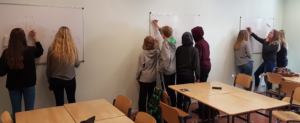After introducing a new topic in mathematics examples are needed to demonstrate how things work, especially in algebra since algebra requires a perfect understanding and there are many details to learn. Traditionally the teacher shows a few examples and discuss them with the class and then students start to work on their own. Two unwanted things might happen when you do this. Firstly, some students might be daydreaming so they have no idea what has been discussed, and those students will have a difficult time working on their own. Secondly, if students have not been given the opportunity to fully understand the problems that might occur in the examples, they might not understand the importance of why you solve a task in a specific way.
There is no need to rush through examples and try to teach everything in a few minutes. Instead students should be given time to work on the examples so that they develop an understanding of the problem before they are presented with hints and solutions. As an example I am going to discuss a class in grade seven who are learning to work with values of variable expressions. Even though the calculations are kind of straight forward, there are many things that can go wrong.
 Take for example the following task: What is the value of “x^2” when “x=-3”. The first time students solve this they are most likely to calculate “-3^2=-9”. Making these kind of mistakes is a good thing since mistakes lay a perfect foundation for discussion. So instead of the teacher immediately just saying how you are supposed to handle this task the students shall work with this task and present a solution for the teacher. The solutions will be discussed and result in a better understanding of what can go wrong and how to prevent these kind of mistakes in the future. The new information will be practised with similar exercises until everyone presents a correct solution and only then do you move on to the next thing.
Take for example the following task: What is the value of “x^2” when “x=-3”. The first time students solve this they are most likely to calculate “-3^2=-9”. Making these kind of mistakes is a good thing since mistakes lay a perfect foundation for discussion. So instead of the teacher immediately just saying how you are supposed to handle this task the students shall work with this task and present a solution for the teacher. The solutions will be discussed and result in a better understanding of what can go wrong and how to prevent these kind of mistakes in the future. The new information will be practised with similar exercises until everyone presents a correct solution and only then do you move on to the next thing.
 Even though this might seem like a minor change in teaching style, the advantages with this method are many. First of all, all of the students are activated in the learning process when they must present a solution for the teacher. Secondly, as a teacher you are able to follow the progress of your students when they are given a chance to solve new problems on their own. Thirdly, students are eager to engage in discussions with one another since their calculations will be presented. Fourthly, the mistakes students will make will serve as a good foundation for discussion and during this discussion students will be more eager to listen and learn from what the teacher has to say. Also, students will come to realize that it is okey to make mistakes, in fact, mistakes are good because you learn from them and this is a healthy and important progress among students if they are to develop a positive attitude towards mathematics. And my fifth and final point is that since the teacher continues to practise until all of the students get it right, the students will feel that they get enough time and guidence in order for them to learn and this is important if they are to develop confidence to be able to work on their own.
Even though this might seem like a minor change in teaching style, the advantages with this method are many. First of all, all of the students are activated in the learning process when they must present a solution for the teacher. Secondly, as a teacher you are able to follow the progress of your students when they are given a chance to solve new problems on their own. Thirdly, students are eager to engage in discussions with one another since their calculations will be presented. Fourthly, the mistakes students will make will serve as a good foundation for discussion and during this discussion students will be more eager to listen and learn from what the teacher has to say. Also, students will come to realize that it is okey to make mistakes, in fact, mistakes are good because you learn from them and this is a healthy and important progress among students if they are to develop a positive attitude towards mathematics. And my fifth and final point is that since the teacher continues to practise until all of the students get it right, the students will feel that they get enough time and guidence in order for them to learn and this is important if they are to develop confidence to be able to work on their own.
Are you looking for a digital math book for junior-high with a built in tool for teachers to share ideas? If you are, please visit Ma.fi (available in English, Swedish and Finnish) for more information.